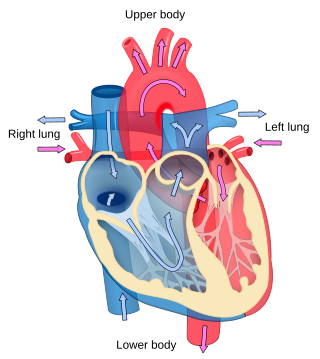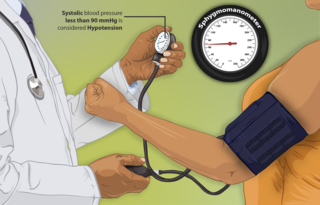Related Research Articles

Cardiology is the study of the heart. Cardiology is a branch of medicine that deals with disorders of the heart and the cardiovascular system. The field includes medical diagnosis and treatment of congenital heart defects, coronary artery disease, heart failure, valvular heart disease, and electrophysiology. Physicians who specialize in this field of medicine are called cardiologists, a sub-specialty of internal medicine. Pediatric cardiologists are pediatricians who specialize in cardiology. Physicians who specialize in cardiac surgery are called cardiothoracic surgeons or cardiac surgeons, a specialty of general surgery.

Blood pressure (BP) is the pressure of circulating blood against the walls of blood vessels. Most of this pressure results from the heart pumping blood through the circulatory system. When used without qualification, the term "blood pressure" refers to the pressure in a brachial artery, where it is most commonly measured. Blood pressure is usually expressed in terms of the systolic pressure over diastolic pressure in the cardiac cycle. It is measured in millimeters of mercury (mmHg) above the surrounding atmospheric pressure, or in kilopascals (kPa). The difference between the systolic and diastolic pressures is known as pulse pressure, while the average pressure during a cardiac cycle is known as mean arterial pressure.

Hypertension, also known as high blood pressure, is a long-term medical condition in which the blood pressure in the arteries is persistently elevated. High blood pressure usually does not cause symptoms itself. It is, however, a major risk factor for stroke, coronary artery disease, heart failure, atrial fibrillation, peripheral arterial disease, vision loss, chronic kidney disease, and dementia. Hypertension is a major cause of premature death worldwide.
A hypertensive urgency is a clinical situation in which blood pressure is very high with minimal or no symptoms, and no signs or symptoms indicating acute organ damage. This contrasts with a hypertensive emergency where severely high blood pressure is accompanied by evidence of progressive organ or system damage.

A sphygmomanometer, also known as a blood pressure monitor, or blood pressure gauge, is a device used to measure blood pressure, composed of an inflatable cuff to collapse and then release the artery under the cuff in a controlled manner, and a mercury or aneroid manometer to measure the pressure. Manual sphygmomanometers are used with a stethoscope when using the auscultatory technique.

Hypotension, also known as low blood pressure, is a cardiovascular condition characterized by abnormally reduced blood pressure. Blood pressure is the force of blood pushing against the walls of the arteries as the heart pumps out blood and is indicated by two numbers, the systolic blood pressure and the diastolic blood pressure, which are the maximum and minimum blood pressures within the cardiac cycle, respectively. A systolic blood pressure of less than 90 millimeters of mercury (mmHg) or diastolic of less than 60 mmHg is generally considered to be hypotension. Different numbers apply to children. However, in practice, blood pressure is considered too low only if noticeable symptoms are present.
Antihypertensives are a class of drugs that are used to treat hypertension. Antihypertensive therapy seeks to prevent the complications of high blood pressure, such as stroke, heart failure, kidney failure and myocardial infarction. Evidence suggests that reduction of the blood pressure by 5 mmHg can decrease the risk of stroke by 34% and of ischaemic heart disease by 21%, and can reduce the likelihood of dementia, heart failure, and mortality from cardiovascular disease. There are many classes of antihypertensives, which lower blood pressure by different means. Among the most important and most widely used medications are thiazide diuretics, calcium channel blockers, ACE inhibitors, angiotensin II receptor antagonists (ARBs), and beta blockers.

White coat hypertension (WHT), also known as white coat syndrome, is a form of labile hypertension in which people exhibit a blood pressure level above the normal range in a clinical setting, although they do not exhibit it in other settings. It is believed that the phenomenon is due to anxiety experienced during a clinic visit. The patient's daytime ambulatory blood pressure is used as a reference as it takes into account ordinary levels of daily stress.

Hypertensive heart disease includes a number of complications of high blood pressure that affect the heart. While there are several definitions of hypertensive heart disease in the medical literature, the term is most widely used in the context of the International Classification of Diseases (ICD) coding categories. The definition includes heart failure and other cardiac complications of hypertension when a causal relationship between the heart disease and hypertension is stated or implied on the death certificate. In 2013 hypertensive heart disease resulted in 1.07 million deaths as compared with 630,000 deaths in 1990.

Ambulatory blood pressure, as opposed to office blood pressure, is the blood pressure over the course of the full 24-hour sleep-wake cycle. Ambulatory blood pressure monitoring (ABPM) measures blood pressure at regular intervals throughout the day and night. It avoids the white coat hypertension effect in which a patient's blood pressure is elevated during the examination process due to nervousness and anxiety caused by being in a clinical setting. ABPM can also detect the reverse condition, masked hypertension, where the patient has normal blood pressure during the examination but uncontrolled blood pressure outside the clinical setting, masking a high 24-hour average blood pressure. Out-of-office measurements are highly recommended as an adjunct to office measurements by almost all hypertension organizations.
Prehypertension, also known as high normal blood pressure and borderline hypertensive (BH), is a medical classification for cases where a person's blood pressure is elevated above optimal or normal, but not to the level considered hypertension. Prehypertension is now referred to as "elevated blood pressure" by the American College of Cardiology (ACC) and the American Heart Association (AHA). The ACC/AHA define elevated blood pressure as readings with a systolic pressure from 120 to 129 mm Hg and a diastolic pressure under 80 mm Hg, Readings greater than or equal to 130/80 mm Hg are considered hypertension by ACC/AHA and if greater than or equal to 140/90 mm Hg by ESC/ESH. and the European Society of Hypertension defines "high normal blood pressure" as readings with a systolic pressure from 130 to 139 mm Hg and a diastolic pressure 85-89 mm Hg.
The cold pressor test is a cardiovascular test performed by immersing the hand into an ice water container, usually for one minute, and measuring changes in blood pressure and heart rate. These changes relate to vascular response and pulse excitability. Some research suggests that the outcome of the cold pressor test can help to predict hypertension in patients; however other studies have failed to confirm this.

Cilnidipine is a calcium channel blocker. Cilnidipine is approved for use in Japan, China, India, Nepal, and Korea for hypertension.

Complications of hypertension are clinical outcomes that result from persistent elevation of blood pressure. Hypertension is a risk factor for all clinical manifestations of atherosclerosis since it is a risk factor for atherosclerosis itself. It is an independent predisposing factor for heart failure, coronary artery disease, stroke, kidney disease, and peripheral arterial disease. It is the most important risk factor for cardiovascular morbidity and mortality, in industrialized countries.
Chi-Ming Chow, FRCPC, FACC, FASE, is a Canadian cardiologist at St. Michael's Hospital in Toronto, Ontario, Canada. He is often interviewed on national media about issues involving cardiovascular health, and is regarded as an influential advocate for heart health in the Canadian Chinese community.

Orthostatic hypertension is a medical condition consisting of a sudden and abrupt increase in blood pressure (BP) when a person stands up. Orthostatic hypertension is diagnosed by a rise in systolic BP of 20 mmHg or more when standing. Orthostatic diastolic hypertension is a condition in which the diastolic BP raises to 98 mmHg or over in response to standing, but this definition currently lacks clear medical consensus, so is subject to change. Orthostatic hypertension involving the systolic BP is known as systolic orthostatic hypertension.

Arterial blood pressure is most commonly measured via a sphygmomanometer, which historically used the height of a column of mercury to reflect the circulating pressure. Blood pressure values are generally reported in millimetres of mercury (mmHg), though modern aneroid and electronic devices do not contain mercury.
Hypertensive disease of pregnancy, also known as maternal hypertensive disorder, is a group of high blood pressure disorders that include preeclampsia, preeclampsia superimposed on chronic hypertension, gestational hypertension, and chronic hypertension.
AFIB Technology is a feature in sphygmomanometer devices that is designed to detect and monitor the incidence of atrial fibrillation in patients. The technology was designed, patented, and is currently used by the Microlife Corporation. It has been the subject of numerous medical studies and has been validated for in-home and clinical use. It can be found in several Microlife devices, including the WatchBP Home A, BP A200 Plus, WatchBP Office, and WatchBP O3.
Hypertension is managed using lifestyle modification and antihypertensive medications. Hypertension is usually treated to achieve a blood pressure of below 140/90 mmHg to 160/100 mmHg. According to one 2003 review, reduction of the blood pressure by 5 mmHg can decrease the risk of stroke by 34% and of ischaemic heart disease by 21% and reduce the likelihood of dementia, heart failure, and mortality from cardiovascular disease.
References
- 1 2 3 Chockalingam A (May 2007). "Impact of World Hypertension Day". The Canadian Journal of Cardiology . 23 (7): 517–9. doi:10.1016/S0828-282X(07)70795-X. PMC 2650754 . PMID 17534457.
- ↑ Chockalingam A (June 2008). "World Hypertension Day and global awareness". The Canadian Journal of Cardiology . 24 (6): 441–4. doi:10.1016/S0828-282X(08)70617-2. PMC 2643187 . PMID 18548140.
- ↑ "World Hypertension Day 2021:Date,Theme,History,Prevention,Significance". S A NEWS. 2021-05-17. Retrieved 2021-05-18.
- ↑ Campbell NR, Petrella R, Kaczorowski J (May 2006). "Public education on hypertension: a new initiative to improve the prevention, treatment and control of hypertension in Canada". The Canadian Journal of Cardiology . 22 (7): 599–603. doi:10.1016/s0828-282x(06)70282-3. PMC 2560867 . PMID 16755315.
- ↑ Hemmelgarn BR, McAlister FA, Grover S, et al. (May 2006). "The 2006 Canadian Hypertension Education Program recommendations for the management of hypertension: Part I--Blood pressure measurement, diagnosis and assessment of risk". The Canadian Journal of Cardiology . 22 (7): 573–81. doi:10.1016/S0828-282X(06)70279-3. PMC 2560864 . PMID 16755312.
- ↑ McKay DW, Godwin M, Chockalingam A (May 2007). "Practical advice for home blood pressure measurement". The Canadian Journal of Cardiology . 23 (7): 577–80. doi:10.1016/s0828-282x(07)70804-8. PMC 2650763 . PMID 17534466.
- ↑ Stergiou GS, Skeva II, Zourbaki AS, Mountokalakis TD (June 1998). "Self-monitoring of blood pressure at home: how many measurements are needed?". Journal of Hypertension . 16 (6): 725–31. doi:10.1097/00004872-199816060-00002. PMID 9663911. S2CID 19565118.
- ↑ Stergiou GS, Skeva II, Baibas NM, Kalkana CB, Roussias LG, Mountokalakis TD (December 2000). "Diagnosis of hypertension using home or ambulatory blood pressure monitoring: comparison with the conventional strategy based on repeated clinic blood pressure measurements". Journal of Hypertension . 18 (12): 1745–51. doi:10.1097/00004872-200018120-00007. PMID 11132597.
- ↑ International Society of Hypertension (ISH)